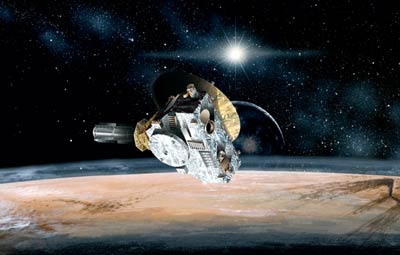Pluto at 75: a uniquely American anniversaryby S. Alan Stern
|
| The ninth planet is the biggest, the brightest, and the first-discovered member of the solar system’s third major architectural zone—the distant and icy Kuiper Belt. |
Not even Tombaugh and his mentors could have forecast how fascinating their new planet would turn out to be. For eventually, when the technology of astronomy made the detailed investigations of bodies as far away and faint as Pluto-Charon possible, this distant planet-satellite pair turned out to be full of enticing surprises. The ninth planet was revealed to be the first known world with a satellite so large it could be called a double planet, a world with complex seasons and a chaotic orbit, and the only planet with an atmosphere that freezes out and then is reborn every orbit. Pluto, replete with polar caps and fresh snows of not one, but three exotic surface ices—methane, nitrogen, and carbon monoxide—is an exotic wonderland on the ragged edge of the solar system’s vast outer wilderness.
Even beyond its own fascinating and scientifically titillating attributes, few in 1930 could have imagined that the discovery of Pluto signaled not just a new planet, but—more importantly—the opening salvo of what would become thousands of discoveries of large, icy bodies on a frontier beyond Neptune. Indeed, with the discovery of the vast population of bodies orbiting beyond Neptune in the early 1990s, Pluto’s cohort, and thus its context became clear: The ninth planet is the biggest, the brightest, and the first-discovered member of the solar system’s third major architectural zone—the distant and icy Kuiper Belt.
The discovery of the Kuiper Belt has fueled a revolution in our understanding of the origin, architecture, and richness of the deep outer solar system. Together, Pluto-Charon and the Kuiper Belt constitute an exciting frontier for scientific exploration, rich with possibilities for illuminating the origin of the planets, the formation of planetary satellites and double planet pairs, the interior properties and surface evolution of icy worlds, and the physics of tenuous atmospheres.
In fact, so valuable are the Pluto-Charon system and its Kuiper Belt companions, that their exploration was ranked as the highest priority new mission to launch in this decade by the National Academy of Sciences in its Planetary Decadal Survey report to NASA.
In the 75 years since Pluto was discovered, the United States has become the leading nation on Earth in both astronomy and space exploration. Making a history for itself that will outlast even this new millennium, the United States has sent the first spacecraft to all of the worlds of our solar system from Mercury to Neptune, and placed teams of human explorers on the Moon six times.
Today the US has robotic explorers orbiting Mars and Saturn, roving the surface of Mars, and on their way to comets, the planet Mercury, and even the boundary with interstellar space. Later in the 21st Century, America aspires to put human explorers on the deserts of Mars and on other worlds.
When the discovery of planet Pluto was announced in March of 1930, no one could have rightfully imagined this would all come to pass within the lifetime of Americans already living in that year. So too, no one might have imagined—in those days when Lindbergh’s crossing of the Atlantic was still a recent technological feat—that Pluto would, within the span of a single human lifetime, be visited by a craft from Earth.
| At the time of its discovery, no one might have imagined that Pluto would, within the span of a single human lifetime, be visited by a craft from Earth. |
Yet the scientific wonderland of Pluto, its giant moon Charon, and the Kuiper Belt is the destination for NASA’s New Horizons mission, which plans to launch in early 2006. If all goes as planned, New Horizons will cross the entire span of the solar system in record time and conduct flyby reconnaissance studies of the Pluto-Charon system in 2015 and then one or more Kuiper Belt objects before 2020.
In accomplishing this historic feat, America will complete the reconnaissance of all the known planets, and provide a new and vivid demonstration of the historic kinds of space exploration that only it has the technical prowess to achieve.
